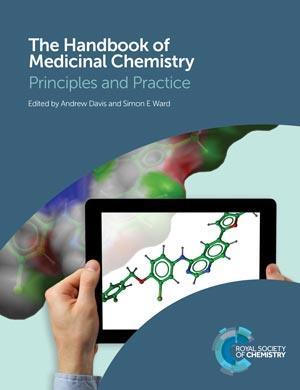Andrew Davis and Simon E Ward (ed)
Royal Society of Chemistry
2015 | 753pp | £84.99
ISBN 9781849736251

Medicinal chemists should have a well-rounded knowledge of the disciplines that contribute to the discovery of new medicines. The handbook of medicinal chemistry: principles and practice guides the reader through the R&D process from target validation to late stage clinical trials, via a series of chapters written by individuals in industry and academia.
Following an introduction by Simon Campbell, which gives a personal and thorough overview of the challenges faced by medicinal chemists, the handbook has three sections; principles, practice and case studies. The ‘principles’ chapters cover key medicinal chemistry tools, as well as related discipline areas. Subsequent chapters on bioinformatics and translational science reflect the evolution of the drug discovery process in recent years.
The ‘practice’ section opens up with a review of modern drug discovery and puts into context the tools explained in previous chapters. This leads into areas that chemists need to be mindful of as drug development approaches. Three case studies included in the section make for an interesting read, reflecting the complexity of getting a drug to market, and highlight that, even at late stages, projects can fail.
This handbook will be a good addition to the medicinal chemist’s bookshelf, especially for those new to drug discovery and others wanting to refresh their knowledge of medicinal chemistry. The hints and tips boxes at the end of each chapter, along with the authors’ key references, provide practical reviews of the salient points, and reflect, in some cases, the authors’ own experiences.
New to this edition is the accompanying Medicinal chemistry toolkit app – compatible with iOS devices. The app contains a selection of interactive tools with offline functionality and a helpful ‘about’ tab explaining its application. I liked the GSlogP, ligand lipophilic efficiency and compound quality calculations tool, which includes a structure sketcher. It calculates compound properties and applies quality filters in real time, with the ‘about’ page referring back to specific chapters within the handbook. There is the option to print the data and structure to pdf. However, I experienced problems with this as only three quarters of any structure transferred to the pdf. This tool could be useful to capture and explore ideas when away from the desk or laptop.
In an academic tutorial or industry journal club, the app could be used to explain and demonstrate principles using current data. It would be good to see the availability extended to other operating systems.
This book is a welcome addition to the medicinal chemist’s book shelf. With over 750 pages, it is certainly a heavy text, but it comprehensively covers the tools and disciplines that medicinal chemists need to be aware of.
With this book, the mind of the medicinal chemist can be more fully prepared to pick the right chances in the pursuit of new drugs.
PurchaseThe handbook of medicinal chemistry: principles and practice from Amazon.co.uk or download the app












No comments yet